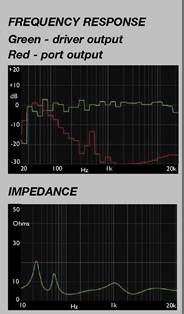The Lumina V from Sonus Faber lights up music Noel Keywood says. Read our Sonus faber Lumina V Review.

These Sonus Faber loudspeakers took me by surprise. They sounded very different to previous ones I’ve reviewed, And against our Martin Logan ESL-X hybrid electrostatic references the Lumina Vs, held their own. Worrying!
Act of faith: box loudspeakers with multiple drive units cannot and do not sound like open panel electrostatics. I ran the Lumina Vs beside our ESL-Xs and differences were obvious. But at times I did wonder whether the Lumina Vs would be more appealing to most listeners. Not “better” just more appealing. Hence my comment of “worrying”. I’ll say more about this later in Sound Quality.
The Lumina Vs come in a standard design format of threeway box loudspeaker, but with a large port hidden in the base. At top of the drive unit array is a 29mm (relatively large) Damped Apex Dome (DAD) silk dome tweeter. The damping at the apex of the dome looked like a small phase-plate to me, a device used to smooth treble response, but a close look showed it wasn’t. A small cone behind the plate actually contacts the top of the tweeter dome to damp it. Hmmm… a novel idea.
Most domes have a diameter of 1in or 25mm; using a bigger one suggests a lower crossover frequency and indeed Sonus Faber quote crossover 2.6kHz instead of the more common 3kHz, benefit being better phase integration at crossover due to longer wavelength.
Below the tweeter sits a 150mm (5in) paper cone midrange driver that covers the important midband, working all the way down to 260Hz. Behind it and the tweeter is a “lute shaped” chamber, Sonus Faber say, that is both rigid and disperses rear waves.
Below the chamber and firing into the rest of the cabinet volume are two 165mm bass units with sandwich cones comprising cellulose pulp sandwiching a ‘syntactic foam’ layer.
Point to note straight away is that metal is not used in any of the drive units, only natural fibres. This gives a darker sound that’s less fast and zingy, but also one that’s more organically natural since there are no resonant materials. It comes down to design ethos: some manufacturers like the bright, speedy sound that comes from metals and stiff synthetics like woven glass fibre, others prefer the easier delivery that comes from plastics and paper.
Not visible is the port that imposes reflex loading upon the two bass units. It faces downward and is surprisingly large, giving lower distortion as a result. Castle used a downward firing port long ago, in the Howard as I recall. It has become popular since then and can be tuned by lifting or lowering the cabinet to alter the acoustic resistance, but few manufacturers do this, including Sonus Faber. The Lumina V cabinet sits on supplied spikes for ground clearance and there are discs that act as optional floor protectors. However, I had great difficulty getting the speakers onto them without damaging the floor first. Feet with attached plastic domes would be preferable. Otherwise the weight of 22.5kg per loudspeaker must be coped with by leaning the speaker over so spikes could be screwed in from below and the speaker tipped back to sit on the metal floor protectors, one side at a time.
The weight comes from a sturdy cabinet with multilayer wood front baffle, ours being finished in walnut with maple inlays, but wenge or black are options. The rear is covered in black leather, Sonus Faber again drawing attention to the fact that this is a “natural” loudspeaker. There are black grilles held on by magnets, for those that would rather hide the drivers.
At 1055mm high on the floor protectors, 280mm wide and 373mm deep the Lumina V is quite tall and imposing.
SOUND QUALITY
I drove the Luminas from our Creek Voyage iA20 amplifier, and also by the Cambridge Audio Evo 150 reviewed in this issue. Cables were Chord Company Signature Reference screened. It struck me that the Luminas would suit our Icon Audio Stereo30 SE single-ended valve amplifier, in sensitivity, tonal balance and revelation, so this was wheeled in last, together with Icon Audio PS3 Mk2 valve phono stage to see just how much stage depth would appear from live recorded LPs in particular.
Where Sonus Fabers of the past have had a bright balance the company seems to have had a change of heart. The tweeter is audibly present – I could hear its contribution – but not by unnatural degree. This has given the Lumina V a reasonably natural balance, rather than an obviously enhanced one shall I say, although it was still forthright up top. Measurement suggested this would be so and it was. I felt comfortable with ‘speaker though: it wasn’t overly bright.
Two qualities hit me straight away. Firstly, there was an impressive amount of insight through the midband that gave strong retrieval of ambience within recordings, especially those from quality hi-res files and – especially – DSD. The Luminas were rather more picky than most as a result, making greater distinction between Johannette Zomer singing Handel’s Love and Madness (DSD) and Renee Fleming singing Un bel di Vedremo from Madame Butterfly (CD), for example. CD came across as vaguely bland. Not the insight ‘ or flow of DSD, which the Lumina Vs made more obvious than usual.

Wherever there was a microphone and someone singing into it the Lumina’s did a lovely job and this endeared them to me straight away. Not only did they convey ambience well but vocals had a natural flavour rather than an artificial one.
Would I cringe at the spitch from Willy DeVille singing Spanish Harlem live (CD) into a microphone? The spitch was obvious but not overwhelming. And Mr DeVille’s voice was believably gritty rather than mechanically edgy.
Swapping between the Lumina Vs and our Martin Logan ESL-X hybrid electrostatics the former were viscerally more punchy, brighter in the high treble and seemingly revealing. The XStat panel of the ML was totally cohesive and far smoother and here the slightly forward nature of the Lumina V tweeter betrayed its multi-driver nature. But the Lumina V had another card up its sleeve that made it visceral: bass.
The second quality to hit me fast was bass output – I’m talking deep bass output here; it was almost worryingly powerful. A standard test track I use, Dadawa’s lovely Canton Story, follows her whispered chant with a huge drum strike and this thundered through the room. It was both deeper and better resolved in textural content than I’ve heard before: I got to hear qualities of the drum itself, a novel experience. Was it too loud? My neighbours probably thought so and I had reservations.
Time to run Lady GaGa’s Bad Romance to see how this track’s thunderous subsonics would fare. The rolling synth that’s used to add weight can confuse and overwhelm a hi-fi loudspeaker trying to properly reproduce it. The Lumina Vs shook this one off with ease, producing enormous subsonics. There was a fat quality to low bass in my 17ft long lounge, as if under-damped, but for sheer weight and enthusiasm few loudspeakers come close at the cabinet size. I tried bass reduction by removing spikes and sitting the cabinets on the floor protectors, reducing the air gap for increased acoustic damping. Bass did lessen but also lost depth and bounce. It wasn’t quite right but a bit of height tuning and/or a layer of foam beneath would likely get things right.
Changing over to our Icon Audio Stereo30 SE single-ended valve amplifier pulled the tweeter back to integrate better, warming and smoothing the delivery.

Spinning our Mobile Fidelity 45rpm re-master of Dire Straits Brothers In Arms I got what I hoped to hear, a big bold analogue sound. Kick drum was arguably a bit too heavy – I was undecided about this. But Knopfler’s vocals and guitar soared out with natural ease, against a silky dark background. There was plenty of high-end sparkle too, the tweeter relishing SE treble.
After playing a slew of high quality LPs I put on some old stinkers from the 60s like John Mayall’s Bare Wires, played to extinction. Could I still listen to it? I got to hear the groove damage, from a Shure M55ED as I recall, but this and other almost embarrassingly bad oldies still had their sense of soul, ample deep bass putting power behind greats like Peter Green and Eric Clapton.
CONCLUSION
Sonus Faber’s Lumina V is what I would call “a serious loudspeaker”. With a seductively natural sound that comes from organic, well damped cone materials, plus a good stab at tonal accuracy, the Lumina V came across as easily engaging. It had great insight, giving atmospheric sound with vocals, plus enormously powerful bass that added prodigious weight. With high sensitivity little power is needed – think 40W or so – so the Lumina V ticks all boxes. This is a loudspeaker that you should hear first, before others, as it sets standards.
MEASURED PERFORMANCE
Our third-octave pink-noise analysis (grille off), with microphone slightly off-axis (10 degrees) shows an impressively flat response down to a low 30Hz. With microphone on-axis there was just slight plateau lift of +1dB above 3kHz, so the Lumina V will sound slightly brighter if pointed directly at listeners, rather than straight down a room. Lack of a dip at the 3kHz crossover frequency will ensure good detail retrieval, and lack of treble lift will keep the highs sounding smooth, not sharp.
There is no lift across the lower midband to add warmth so the Lumina V is likely to sound dry but accurate. It is best used close to a rear wall to raise low frequencies by what is termed ‘room gain’ where a room’s modal frequencies emphasise bass. Bass extends very low, aided by a large port in the plinth. Large diameter ports produce less distortion (around half) than small ones so this one tuned to 40Hz looked potentially effective.
With pink noise overall impedance measured 5.6 Ohms, the bass unit measuring 3.6 Ohms d.c.r. Sensitivity was very high at 90dB from one nominal Watt (2.8V) of input. The Lumina V will run very loud from little power, no more than 40 Watts being needed.
This is an accurate loudspeaker that runs very low, so will have deep bass. Needing little power it will give a fine result with any amplifier.

+44 (0) 1592 744 710
www.finesounds.uk
VERDICT
When you purchase through links on our site, I may earn an affiliate commission. Here’s how it works.
The World's First Unboxing of the Sonus faber Lumina V
After a long wait, our Sonus faber Lumina V's finally arrived at the store. Adrian unboxes the speaker and goes over some of the ...










Excellent review, thank you.
Can i ask your opinion please?
I have a cambridge Cx81, project carbon evo turntable with auditechnica 750 sh stylus, rega mm preamp.
I am tossing up between the faber sonus lumina 5 and B&W 703 s2.
Any thoughts would be appreciated!
Purchased over Christmas 2021! Initially I bought the Lumina III, but they lacked bass response, so upgraded to Lumina V!!! Wow what a difference and well worth spending the extra money. The design is very good and matches my furniture.
Matched with Marantz 5015 amp and REL Tx7 sub. Great combo.
I only use the Sub for movies to get some rumble, else I keep it switched off as the Lumina V’s perform better without. Bass, mid and treble is perfect, can hear sounds that normally I didn’t hear.
Good track to test is Saville from Mission Impossible 2 – play the whole track to the end and then compare to other speakers.
Well worth the money and highly recommend them.
Thanks for your information!